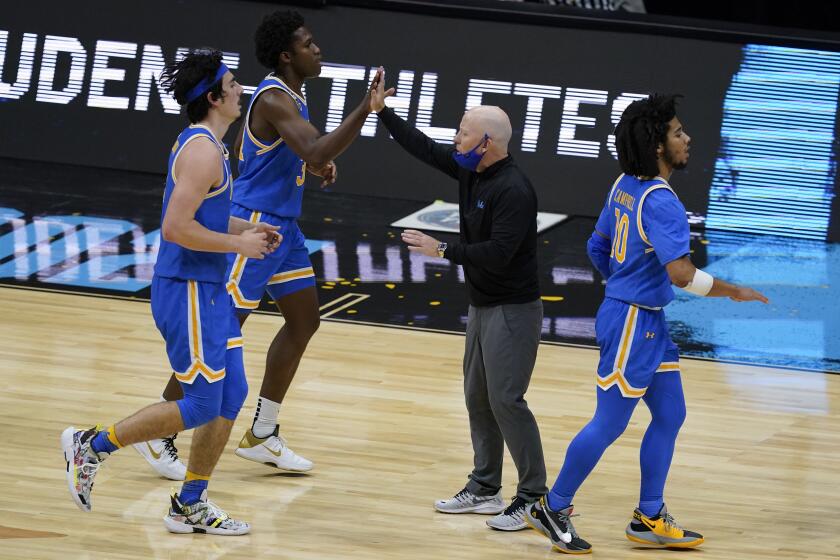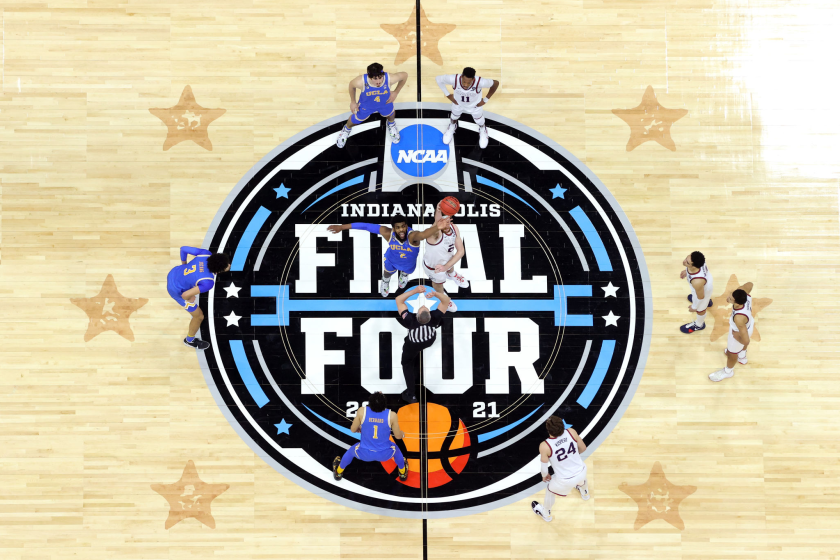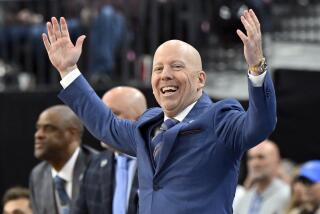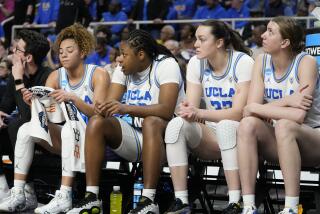UCLA’s Final Four run reminiscent of the team that sparked John Wooden’s dynasty
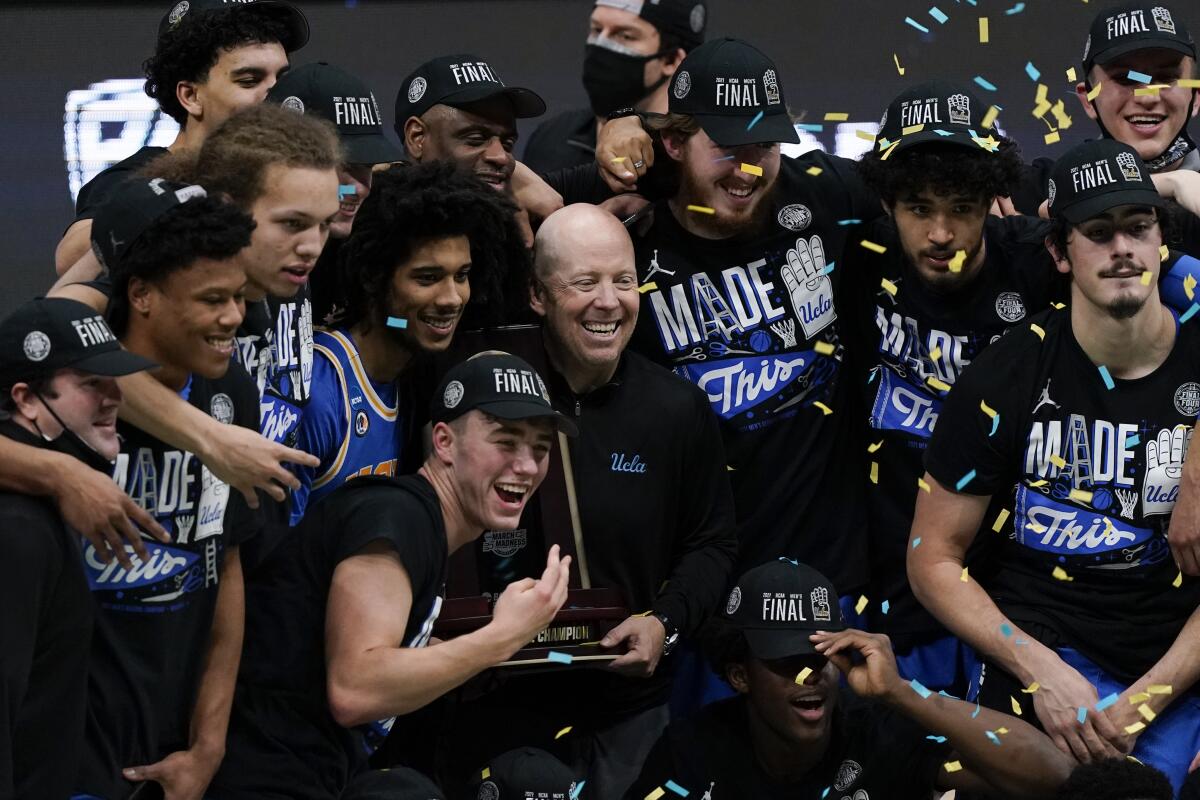
It was a team without height, without expectations, without a prayer.
Underdog UCLA barreled its way into the Final Four that season, not just discounted but ignored, Sports Illustrated describing the Bruins as “the team nobody heard of.”
They faced a heavy favorite in the national semifinal, scratching their way toward a taut finish before falling short in the last seconds, on a crazy shot nobody expected to go in.
The year was 1962 — and 2021.
Startling similarities between the team that sparked John Wooden’s dynasty and the one that has made Mick Cronin more popular than free parking in Westwood have some longtime Bruins observers drawing happy parallels that they hope result in a similar postscript.
Coach Mick Cronin and UCLA restored faith in a basketball program poised to see more glory in the seasons ahead, Times columnist Helene Elliott writes.
Gary Cunningham, a senior captain of the 1961-62 team, started connecting the dots about a week after Gonzaga’s Jalen Suggs sank a 40-footer to beat UCLA in overtime earlier this month. It reminded Cunningham of the pain he felt after Cincinnati’s Tom Thacker buried a 25-footer to thwart his Bruins at the same stage of the NCAA tournament some 59 years earlier.
“We were heartbroken,” Cunningham, 81, said this week from his home in Goleta. “We were kind of the Cinderella team.”
Like the most recent vintage Bruins, Cunningham’s team entered the NCAA tournament with one of the worst records of any participant. They got off to a slow start that season and were undersized, with the 6-foot-5 Fred Slaughter a de facto center and the 6-foot-7 Cunningham the tallest player on the team.
A valiant effort during a loss to nationally ranked Ohio State in December — a repeat scenario played out this season — convinced the Bruins they were capable of playing with anyone. That was also around the time sophomore playmaker Walt Hazzard’s adventurous passes started finding his teammates’ hands more often than the third row of seats.
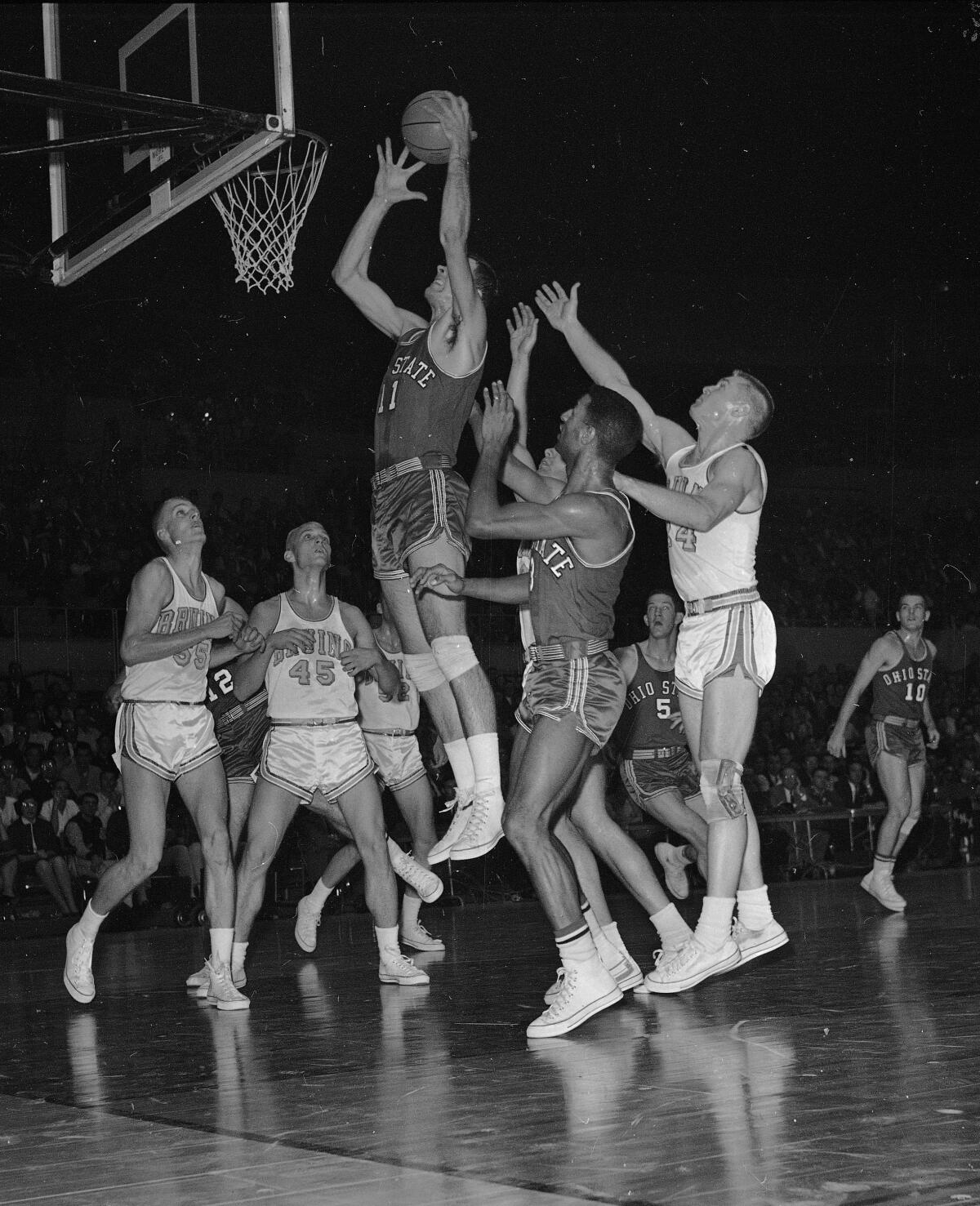
“If you got open, you got the ball,” Cunningham said, “and we weren’t used to that, and wow, here comes the ball.”
UCLA featured balance, four players averaging double figures in scoring (this season’s team had six players reach that threshold), but little depth, with Wooden rarely using his bench for more than spot minutes. That meant starters Cunningham, Hazzard, Slaughter, Pete Blackman and John Green rested only occasionally, a predicament familiar to heavily used current Bruins Tyger Campbell and Jaime Jaquez Jr.
In perhaps the biggest departure from the most recent UCLA team, which staggered its way into the NCAA tournament with four consecutive losses, Cunningham’s Bruins went 12-2 down the stretch to win the Athletic Assn. of Western Universities.
They were still expected to lose their NCAA tournament opener against Utah State. UCLA needed Cunningham’s 21 points on nine-for-18 shooting to prevail, 73-62, after the Bruins lost a 13-point halftime lead. In the West Region final against Oregon State, UCLA withstood 7-footer Mel Counts’ 24 points and 17 rebounds because no other Beaver did much of anything during the Bruins’ 88-69 rout.
That sent UCLA to the Final Four for the first time under Wooden, then in his 14th season with the Bruins.
“I like to think that our team was the start of Wooden’s dynasty.”
— Gary Cunningham
“Gall, a couple of guards and a blistering attack,” read an SI account that could apply to the Bruins today just as it did more than half a century ago, “had brought them some most unexpected success.”
Cincinnati, the defending national champion, was expected to crush UCLA in a national semifinal. The Bearcats raced to a 14-point lead in the opening minutes before Cunningham started draining jumpers, reminding everybody why it had been a fool’s errand to dismiss this team. The Bruins fought all the way back, forging a halftime tie.
“A characteristic of our team was we never gave up,” Cunningham said. “It was kind of like the UCLA team this year; they would get behind and then they just kept playing hard and we didn’t know any other way than to play hard.”
Cunningham might have taken the game’s final shot had not been for a controversial charging call, something that also haunted the Bruins this month in the waning seconds of regulation against Gonzaga when Johnny Juzang was penalized for colliding with Drew Timme.
UCLA’s basketball team provided more compelling stories than any beat writer could have imagined. An inside look at the Bruins’ run to the Final Four.
The call that went against Hazzard gave Cincinnati the ball with the score tied, allowing the Bearcats to call timeout and set up a final play with 10 seconds left. The ball was supposed to go to Paul Hogue, who had scored Cincinnati’s previous 14 points, but wound up in the hands of Thacker, who had missed all six of his shots and was not known for long-range accuracy.
No matter. His jumper from beyond the modern NBA three-point arc went through the net with three seconds left. The upstart Bruins were finally upended.
“It ended up that a guy that couldn’t shoot at all — I mean, he was a terrible outside shooter — throws it in and we lose by two,” Cunningham said, his surprise still palpable all these years later.
The epilogue considerably softened that final blow. Two years later, a team with Hazzard and Slaughter back as savvy seniors toppled Duke to give Wooden his first national championship while providing the departed Cunningham with a measure of satisfaction.
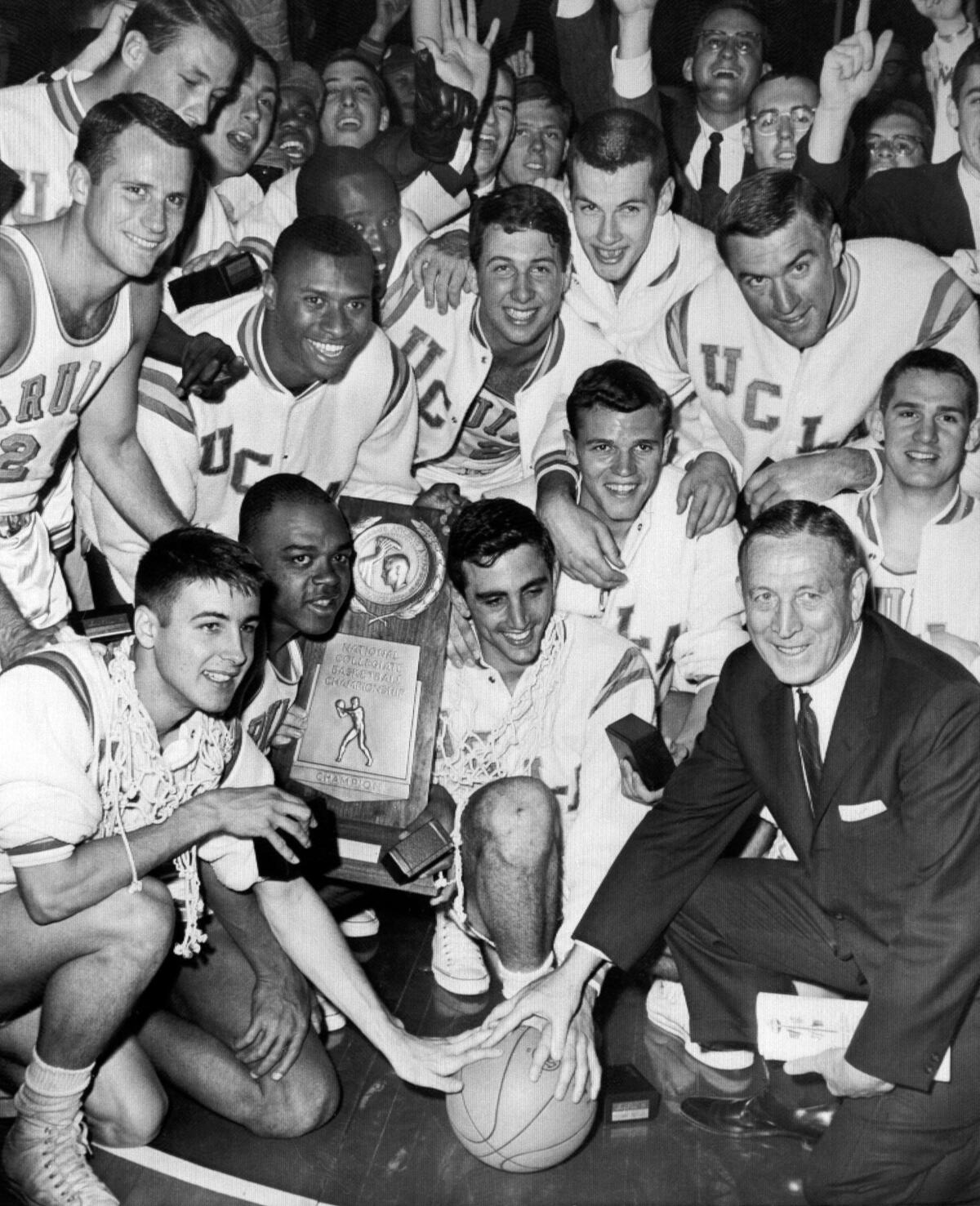
“I like to think that our team,” Cunningham said, “was the start of Wooden’s dynasty.”
Cunningham would return to UCLA after a brief professional career, serving as an assistant coach under Wooden for eight of his 10 titles. Cunningham’s 50-8 record as UCLA’s head coach from 1977-79, including one appearance in an NCAA tournament regional final, made him the surprising answer to a trivia question given the unprecedented success of his predecessor: Which UCLA basketball coach has the highest winning percentage?
“Coach Wooden used to like to tell people that when we were at a banquet or something,” Cunningham said with a laugh, of having won 86.2% of his games before becoming a career athletics administrator.
Cunningham is among the Bruin faithful that hope Cronin’s first foray to a Final Four is a prelude to something even more special, though no one is expecting anything like Wooden’s haul of titles. For one thing, Cunningham pointed out how much harder it is to reach a Final Four these days than the two victories required when he was playing in the NCAA tournament.
Cronin’s Bruins won five games to get there this season, joining Virginia Commonwealth as the only teams to advance from a First Four to a Final Four. To Cunningham, it felt like a coach taking the first step rather than reaching his destination.
“My colleagues, the people that I played with, other UCLA people,” Cunningham said, “are really excited about the job that he’s done and the future of UCLA basketball.”
More to Read
Go beyond the scoreboard
Get the latest on L.A.'s teams in the daily Sports Report newsletter.
You may occasionally receive promotional content from the Los Angeles Times.

